Hemodynamically motivated choice of patch angioplasty for the performance of carotid endarterectomy
- PMID: 22923061
- PMCID: PMC12054739
- DOI: 10.1007/s10439-012-0640-2
Hemodynamically motivated choice of patch angioplasty for the performance of carotid endarterectomy
Abstract
Patch angioplasty is the most common technique used for the performance of carotid endarterectomy. A large number of materials are available, but little is known to aid the surgeon in choosing a patch while caring for a patient with carotid disease. The objective of this study was to investigate biomechanics of the carotid artery (CA) repaired with patch angioplasty, study the influence of patch width and location of closure on hemodynamics, and to select the optimal patch material from those commonly used. For this purpose, a mathematical model was built that accounts for fluid-structure interaction, three-dimensional arterial geometry, non-linear anisotropic mechanical properties, non-Newtonian flow and in vivo boundary conditions. This model was used to study disease-related mechanical factors in the arterial wall and blood flow for different types of patch angioplasty. Analysis indicated that patch closures performed with autologous vein and bovine pericardium were hemodynamically superior to carotid endarterectomy with synthetic patch angioplasty (polytetrafluoroethylene, Dacron) in terms of restenosis potential. Width of the patch and location of arteriotomy were found to be of paramount importance, with narrow patches being superior to wide patches, and anterior arteriotomy being superior to the lateral arteriotomy. These data can aid vascular surgeons in their selection of patch angioplasty technique and material for the care of patients undergoing open CA repair.
Figures
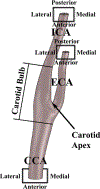

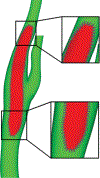
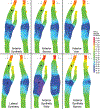



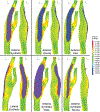
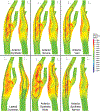

Similar articles
-
Patches of different types for carotid patch angioplasty.Cochrane Database Syst Rev. 2021 Feb 18;2(2):CD000071. doi: 10.1002/14651858.CD000071.pub4. Cochrane Database Syst Rev. 2021. PMID: 33598915 Free PMC article.
-
A mathematical evaluation of hemodynamic parameters after carotid eversion and conventional patch angioplasty.Am J Physiol Heart Circ Physiol. 2013 Sep 1;305(5):H716-24. doi: 10.1152/ajpheart.00034.2013. Epub 2013 Jun 28. Am J Physiol Heart Circ Physiol. 2013. PMID: 23812386 Free PMC article.
-
Comparative analysis of the biaxial mechanical behavior of carotid wall tissue and biological and synthetic materials used for carotid patch angioplasty.J Biomech Eng. 2011 Nov;133(11):111008. doi: 10.1115/1.4005434. J Biomech Eng. 2011. PMID: 22168740 Free PMC article.
-
Closure technique after carotid endarterectomy influences local hemodynamics.J Vasc Surg. 2014 Aug;60(2):418-27. doi: 10.1016/j.jvs.2014.01.069. Epub 2014 Mar 20. J Vasc Surg. 2014. PMID: 24657293
-
A meta-analysis of randomized trials comparing bovine pericardium and other patch materials for carotid endarterectomy.J Vasc Surg. 2018 Oct;68(4):1241-1256.e1. doi: 10.1016/j.jvs.2018.07.023. J Vasc Surg. 2018. PMID: 30244928 Review.
Cited by
-
Biomechanical Aspects of Closing Approaches in Postcarotid Endarterectomy.Comput Math Methods Med. 2018 Oct 28;2018:4517652. doi: 10.1155/2018/4517652. eCollection 2018. Comput Math Methods Med. 2018. PMID: 30510592 Free PMC article.
-
Hemodynamic evaluation of endarterectomy and stenting treatments for carotid web.Front Cardiovasc Med. 2022 Oct 20;9:993037. doi: 10.3389/fcvm.2022.993037. eCollection 2022. Front Cardiovasc Med. 2022. PMID: 36337875 Free PMC article.
-
Computational hemodynamic pathophysiology of internal carotid artery blister aneurysms.Biomed Eng Online. 2024 Nov 21;23(1):118. doi: 10.1186/s12938-024-01306-z. Biomed Eng Online. 2024. PMID: 39574149 Free PMC article.
-
An in vivo study of a gold nanocomposite biomaterial for vascular repair.Biomaterials. 2015 Oct;65:175-83. doi: 10.1016/j.biomaterials.2015.06.045. Epub 2015 Jun 30. Biomaterials. 2015. PMID: 26164402 Free PMC article.
-
A Comparison of Vessel Patch Materials in Tetralogy of Fallot Patients Using Virtual Surgery Techniques.Ann Biomed Eng. 2023 Jul;51(7):1420-1435. doi: 10.1007/s10439-023-03144-x. Epub 2023 Feb 1. Ann Biomed Eng. 2023. PMID: 36723833
References
-
- AbuRahma AF, Robinson PA, Saiedy S, Kahn JH, and Boland JP Prospective randomized trial of carotid endarterectomy with primary closure and patch angioplasty with saphenous vein, jugular vein, and polytetrafluoroethylene: long-term follow-up. J. Vasc. Surg 27(2):222–234, 1998. - PubMed
-
- AbuRahma AF, Stone PA, Flaherty SK, and AbuRahma Z. Prospective randomized trial of Acuseal (Gore-Tex) versus Hemashield-Finesse patching during carotid endarterectomy: early results. J. Vasc. Surg 45(5):881–884, 2007. - PubMed
-
- American College of Cardiology Foundation, American Society of Interventional & Therapeutic Neuroradiology, Society for Cardiovascular Angiography, Interventions, Society for Vascular Medicine, Biology, Society of Interventional Radiology, Bates ER, Babb JD, Casey DE, Cates CU, Duckwiler GR, Feldman TE, Gray WA, Ouriel K, Peterson ED, Rosenfield K, Rundback JH, Safian RD, Sloan MA, and White CJ ACCF/SCAI/SVMB/SIR/ASITN 2007 clinical expert consensus document on carotid stenting: a report of the American College of Cardiology Foundation task force on clinical expert consensus documents (ACCF/SCAI/SVMB/SIR/ASITN clinical expert consensus document committee on carotid stenting). J. Am. Coll. Cardiol 49(1):126–170, 2007. - PubMed
-
- Archie JP How can I achieve the optimal flow surface and distal end-point following carotid endarterectomy? In: Carotid Artery Surgery: A Problem-Based Approach, edited by Naylor RA and Mackey WC London:Harcourt, 1999, pp. 262–270.
-
- Awad IA, and Little JR Patch angioplasty in carotid endarterectomy. Advantages, concerns, and controversies. Stroke. 20(3):417–422, 1989. - PubMed
Publication types
MeSH terms
Grants and funding
LinkOut - more resources
Full Text Sources
Other Literature Sources
Medical

